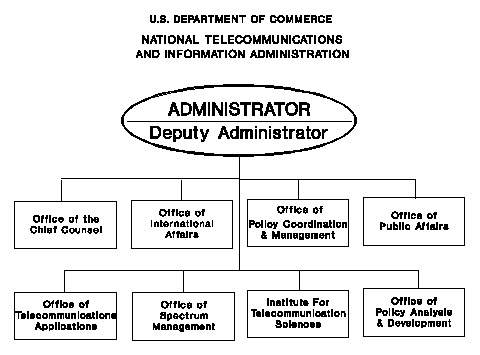The National Telecommunications and Information Administration (NTIA) of the U.S. Department of Commerce was established in 1978 by Executive Order 12046. NTIA is the Executive branch telecommunications policy advisor to the President and the manager of Federal Government uses of the spectrum. NTIA responsibilities are divided among five offices and three staff groups, shown below, which work together to investigate the changing field of telecommunications as America approaches the twenty-first century.

The Office of International Affairs (OIA) provides policy analysis, technical guidance and recommendations that advance the strategic interests and the international competitiveness of the United States. OIA, together with the Office of Spectrum Management, has a leadership role in preparing for the many conferences and meetings of the International Telecommunication Union.
The Office of Telecommunication Applications (OTA) assists in the development of educational and public telecommunications services through the Public Telecommunications Facilities Program. This program provides grants for the improvement of public radio and television facilities.
The Office of Spectrum Management (OSM), with offices in Washington, DC and Annapolis, MD, develops and implements policies and procedures for domestic issues regarding the use of the spectrum and assigning frequencies to the stations operated by the Federal Government in the United States. OSM develops long range plans and policies for the management of the spectrum, the review of Federal radiocommunication systems to make sure that sufficient spectrum is available for their compatible operation, the analysis and resolution of interference problems involving Federal radiocommunication systems, and the analysis of spectrum use in selected bands through the use of state-of-the-art analytic and measurement techniques.
The Institute for Telecommunication Sciences (ITS), located in Boulder, CO, is NTIA's chief engineering and research arm. ITS is a centralized Federal laboratory that addresses a great diversity of technical issues associated with telecommunications. ITS addresses both spectrum related and wireline issues associated with telecommunications.
NTIA's Office of Policy Analysis and Development (OPAD) is responsible for NTIA's domestic and Federal communications policy development. OPAD develops policy recommendations on the introduction of competition into, and deregulation of, the telecommunication industry. The Office prepares wide-ranging studies of the U.S. telecommunication industry and the policies that affect it. OPAD also, in close coordination with NTIA's Office of Chief Counsel, prepares pleadings for telecommunication policy proceedings conducted by the FCC.

|
To be contacted for a confidential consultation please E-mail: jmatk@tscm.com
or send a letter via US Mail to:
or call:
URL: http://www.tscm.com/ |